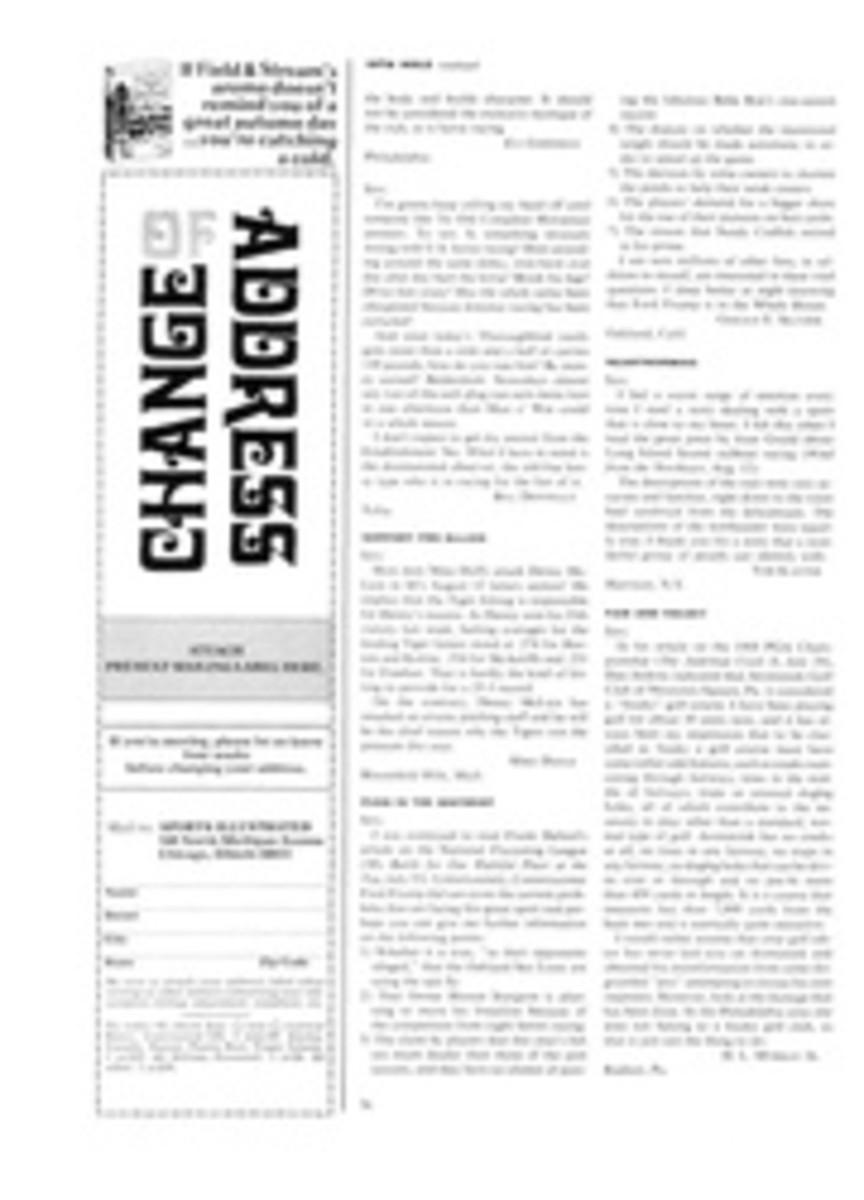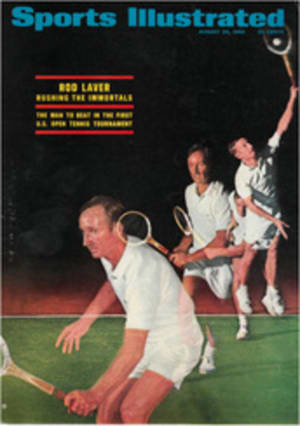
It looks like our cup again
The main reasons for the considerable charm and appeal Davis Cup play holds for people, whether or not they are outright tennis fans, are that the competition is sufficiently old (the first Challenge Round was held in 1902), sufficiently amateur and sufficiently tradition-encrusted to please the establishmentarian instinct. It is also a sporting event with true worldwide participation. This year 49 nations entered teams in one of four zones—two European, one Asian and one American—to determine which will challenge Australia, the present cup holder, in December. Finally, and perhaps most significantly, it provides the closest approximation in sports to the star system. Give a country—no matter how small—one super player, and it is ready to challenge the world.
The United States has become quite aware of this in the past eight years. Since 1959—except for 1963, when we won the ornate sterling cup from the Aussies, and 1964, when we graciously returned it—all sorts of upstart nations have kept the U.S. from the Challenge Round. Italy did it in 1960 and 1961. Then came Mexico in 1962, Spain in 1965, Brazil in 1966 and, last and least, Ecuador in 1967.
But last week, under the new management of Captain Donald Dell (SI, June 10) and in the unlikely surroundings of Roxboro Junior High School in Cleveland Heights, Ohio, we took the cup again. Practically speaking, anyway. Going into the weekend, the original list of 49 nations had been narrowed to five—West Germany, India, Japan, Spain and the United States. Coming out, the list was down to four. West Germany has yet to play either India or Japan, but the United States had defeated Spain and earned the right to meet the survivor of the other half of the Interzone draw. Next will come the Challenge Round in Adelaide and, unfortunately for the Aussies, the three players who defended last year—John Newcombe, Roy Emerson and Tony Roche—are now professionals. Unless Captain Harry Hopman manages the most amazing feat of his career with the likes of Ray Ruffles, Bill Bowrey and Barry Phillips-Moore, the cup will come back to the nation which donated it in the first place.
Spain, far superior to West Germany, Japan or India—the reason why last week's tie was so important—showed up in Cleveland with its star, Manuel Santana, who has been playing in cup competition with profound success for 10 years, and Santana's support, Juan Gisbert, who beat Dennis Ralston in four sets in 1965 during the U.S.-Spain match that Spain won and earlier this year was graduated from the University of Barcelona law school. From the time that the draw was made on Thursday afternoon it was obvious that for Spain to win, Santana would have to take his two singles matches and somehow carry Gisbert through to a victory in the doubles match that provides the fifth point in Davis Cup play.
The two singles players Dell nominated were the two who reached the semifinals of the first open Wimbledon earlier in the summer: Clark Graebner, who grew up in Beachwood, Ohio, just around the corner from Cleveland Heights; and Arthur Ashe, the slender ("I've never had an injury in my life; there's not enough muscle on me for anything to go wrong"), phlegmatic Army lieutenant from Richmond. In reserve, Dell had Charlie Pasarell of Puerto Rico, who had beaten Graebner in the finals of the Eastern Grass Court Championships at South Orange, N.J. two weeks earlier and had carried Ken Rosewall, the world's No. 2-ranking player, to five sets at Wimbledon.
Before play began Dell was optimistic but politely cautious. Ralston, who is now a professional and the U.S. coach, said, "This should be easy. Gisbert is no problem. But anything can happen. One guy can raise his game, another can get nervous, or lose concentration—anything." Spanish Captain Jaime Bartroli said simply, "We need points from everybody."
The first match of the tie put Graebner against Santana. The former ball boy from Madrid is now 30—surely not ancient—and still a master on slow surfaces. The courts at the 6,200-seat Harold T. Clark Stadium at Roxboro Junior High are fast—a composition called Tenni-Flex on an asphalt base—but the Spaniard played as if he were back home on the soggy European clay. He served few aces, but gained control of the points by alternately serving wide to Graebner, who does not move well, then handcuffing Graebner with a service right at him. Then he followed with deft, accurate ground strokes and sharply angled volleys.
For his part, Graebner, who had beaten Santana in straight sets at Wimbledon, was nowhere near the peak of his game, and said bluntly after the match, "I played pretty bad, didn't I?" During the first set and until midway into the second he only occasionally bothered to follow his service to the net, mainly because there was nothing to follow. His first service went in only 54% of the time, and Santana was able to return the second with ease. The match ended quickly, and for Graebner disastrously, 6-2, 6-3, 6-3.
Ashe and Gisbert were next up. Like Santana, Gisbert is at his best on slow clay (the surface, incidentally, on which the U.S. has been defeated in every year beginning with 1961) but, unlike Santana, he cannot adjust away from it. This match ended quickly, too—in Ashe's favor, 6-2, 6-4, 6-2—and the series was tied 1-1.
The doubles on the second day, then, became what everybody figured it would be: the crucial match of the tie. And both captains used their prerogative and did not announce their player selections until one hour before the match was to begin. On the way to the Interzone semifinal, which included Spanish victories over The Netherlands, Sweden, Great Britain and Italy, Santana had played twice with Luis Arilla, a 10-year cup veteran, once with Manuel Orantes, just turned 19, and had sat out one match. The logical choice was Santana-Arilla, but during practice earlier in the week Arilla had pulled a leg muscle, forcing Bartroli to choose Gisbert and to keep Orantes, an unknown quantity in major competition, on the sidelines.
Dell and Ralston did not decide on their choices until late on the night of the first day, and finally picked Pasarell and Graebner. The other possibility was Bob Lutz, who had actually looked the best of the Americans in doubles play, but, like Orantes, was untested. In earlier ties against the British West Indies, Mexico and Ecuador, Lutz had played twice with Stan Smith and once with Graebner, but in all three instances the United States had had 2-0 leads at the end of the first day.
Graebner needed the match to restore his somewhat frayed confidence and to work out the problems with his service, and Pasarell was picked because, when he chooses, he is the most tenacious and gutty player in the country. "All I want to do is win," he said. "I don't care if we look good, bad or indifferent doing it. I just want to win."
The Americans were heavily favored in the doubles but, surprisingly, that match turned out to be the best of the tie. Perry Jones, now 81 and the person most responsible for the tremendous amount of tennis talent produced in Southern California for decades, said later, "This was one of the most interesting doubles I've seen in 50 years."
Graebner went into the match still worried about his service. "You know how big a part of my game it is," he said. "This morning during practice it was still terrible." Graebner needed eight points to hold service his first time up, but, as it turned out, did not lose it the entire afternoon.
The first set went to Spain 13-11, and it is fortunate Pasarell had such a self-effacing attitude toward his game, because while serving at set point, in the 24th game of the set, he double-faulted. That was bad enough, but it was more the way he did it. After missing his first service, as he said, "I threw the ball up wrong, the wind [a considerable 17 mph] carried it away from me and I choked." He barely made contact with the ball and it sailed, like a knuckleball, not only over the net but over a surprised Gisbert, a shocked Santana and an indifferent baseline umpire in the general direction of Lake Erie.
The second set was even longer—32 games—but chinks were developing in the Spanish armor. The obvious American strategy was to play Gisbert, but he was difficult to find. Santana was everywhere, exhorting himself, exhorting Gisbert and occasionally running from sideline to sideline on consecutive shots while Gisbert watched the action only as an interested observer. Santana poached whenever he could, and this, of course, often left his sideline unprotected while Gisbert was serving.
In the 31st game of the set, with Gisbert behind 15-30, Pasarell went for that sideline and passed Santana to give the Americans two break points. They only needed one. Pasarell held his service for the set, and even Dell, who had not been too sure up to that point, permitted himself a smile. The second set was the key to the match, and the match—11-13, 17-15, 7-5, 6-2—the key to the tie. It had taken three hours, 45 minutes. 422 points and 12 quarts of Gatorade, the unofficial official U.S. team drink, to play.
Even though Spain, which trailed 2-1, still had a chance going into the third day, in which the first afternoon's singles assignments were reversed, the tie was over. Graebner, full of the confidence he had lost against. Santana and regained in the doubles, disposed of Gisbert in straight sets, 9-7, 6-3, 6-1, to give the United States the third and deciding point. That relegated the final match between Ashe and Santana to the status of pride only. Both played superbly; Santana won the first and fourth sets (13-11, 15-13), Ashe the second and third (7-5, 6-3), when darkness forced postponement of the fifth. Ashe finally won the next day 6-3. It was a fitting conclusion to a good tie, and surely the most important one the United States team will play all year.
PHOTO
FOUR FEET IN THE AIR, the U.S. team leaps in unison as Clark Graebner smashes an overhead against the Spaniards in the decisive four-set doubles match in Cleveland that virtually assured the eventual return of the Davis Cup.

